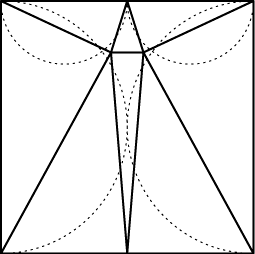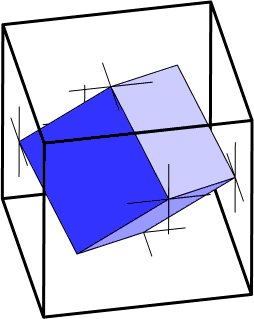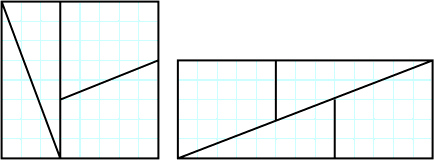
Rectilinear Geometry
This includes geometric problems defined on squares and rectangles,
higher dimensional boxes, cubes, and hypercubes,
right triangles and other right-angled figures,
and "taxicab geometry" in which distances are measured
in terms of axis-parallel paths.
- Acute square triangulation.
Can one partition the square into triangles with all angles acute?
How many triangles are needed, and what is the best angle bound possible?
- Animated proof
of the Pythagorean theorem, M. D. Meyerson, US Naval Academy.
- Antipodes.
Jim Propp asks whether the two farthest apart points,
as measured by surface distance, on a symmetric convex body
must be opposite each other on the body.
Apparently this is open even for rectangular boxes.
- An aperiodic set of Wang cubes, J. UCS 1:10 (1995).
Culik and Kari describe how to increase the dimension of sets of
aperiodic tilings, turning a 13-square set of tiles into a 21-cube set.
- Box in a box.
What is the smallest cube that can be put inside another cube
touching all its faces?
There is a simple solution, but it seems difficult to prove its correctness.
The solution and proof are even prettier in four dimensions.
- Calabi's triangle constant, defining the unique non-equilateral triangle
with three equally large inscribed squares.
Is there a three-dimensional analogue?
From MathSoft's favorite constants pages.
- Circular quadrilaterals.
Bill Taylor notes that if one connects the opposite midpoints
of a partition of the circle into four chords, the two line segments
you get are at right angles. Geoff Bailey supplies an elegant proof.
- Covering points by rectangles.
Stan Shebs discusses the problem of finding a minimum number of
copies of a given rectangle that will cover all points in some set,
and mentions an application to a computer strategy game.
This is NP-hard, but I don't know how easy it is to approximate;
most related work I know of is on optimizing the rectangle size for a cover
by a fixed number of rectangles.
- CSE
logo. This java applet allows interactive control of a rotating
collection of cubes.
- Cube
Dissection. How many smaller cubes can one divide a cube into?
From Eric Weisstein's
treasure trove of mathematics.
- Cube triangulation.
Can one divide a cube into congruent and disjoint tetrahedra?
And without the congruence assumption,
how many higher dimensional simplices are needed to triangulate a hypercube?
For more on this last problem, see
Triangulating
an n-dimensional cube, S. Finch, MathSoft,
and
Asymptotically efficient
triangulations of the d-cube, Orden and Santos.
- DeVicci's Tesseract.
Higher-dimensional generalizations of Prince Rupert's cube,
from MathSoft's favorite constants pages.
- Distances on
the surface of a rectangular box, illustrated using colored wavefronts
in this Java applet by Henry Bottomley.
- Distinct point set with the same distance multiset.
From K. S. Brown's Math Pages.
- Fake dissection.
An 8x8 (64 unit) square is cut into pieces
which (seemingly) can be rearranged to form a 5x13 (65 unit) rectangle.
Where did the extra unit come from?
Jim Propp asks about possible three-dimensional generalizations.
Greg
Frederickson supplies one.
See also
Alexander
Bogomolny's dissection of a 9x11 rectangle into a 10x10 square and
Fibonacci
bamboozlement applet.
- Four dice hypercube visualization.
- Golden rectangles, Curtis McMullen.
- How to construct a golden rectangle, K. Wiedman.
- Hypercube fun.
John Atkeson finds a nice recursive drawing pattern for high dimensional
hypercubes in two dimensional planes.
- Hypercube game.
Experience the fourth dimension with an interactive, stereoscopic
java animation of the hypercube.
- Hypercube visualization,
Drew Olbrich.
- Hypercubes
in hyper perspective. Red-blue 3d visualizations produced with the
virtual flower system.
- Intersecting cube diagonals.
Mark McConnell asks for a proof that, if a convex polyhedron
combinatorially equivalent to a cube has three of the four
body diagonals meeting at a point, then the fourth one meets
there as well. There is apparently some connection to toric varieties.
- Keller's cube-tiling conjecture is false in high dimensions,
J. Lagarias and P. Shor, Bull. AMS 27 (1992).
Constructs a tiling of ten-dimensional space by unit hypercubes
no two of which meet face-to-face, contradicting a
conjecture
of Keller
that any tiling included two face-to-face cubes.
- Richard
Kenyon's Gallery of tilings by squares and equilateral triangles of
varying sizes.
- Knight's tour
art,
Dan Thomasson.
- Maximum
area cross-section of a hypercube.
- N-dimensional cubes, J. Bowen, Oxford.
- No cubed cube.
David Moews offers a cute proof that no cube can be divided into smaller
cubes, all different.
- Nonorthogonal polyhedra built from rectangles.
Melody Donoso and Joe O'Rourke answer an open question of Biedl, Lubiw,
and Sun.
- Orthogonal discrete knots.
Hew Wolff asks questions about the minimum total length, or the minimum volume of a rectangular box, needed to form different knots as three-dimensional polygons using only integer-length axis-parallel edges.
- Packing rectangles into similar rectangles.
A problem of the month from Erich Friedman's Math Magic site:
how small an aspect-ratio-r rectangle can contain n unit-area
aspect-ratio-r rectangles?
As you might hope for in a problem dealing with aspect ratios
of rectangles, the golden rectangle does show up, as one of the
breakpoints in the size function for packing five smaller rectangles.
- The Partridge
Puzzle. Dissect an (n choose 2)x(n choose 2)
square into 1 1x1 square, 2 2x2 squares, etc.
The 30-60-90
triangle version of the puzzle is also interesting
- Pi
squared by six rectangle dissected into unequal integer squares
(or an approximation thereof) by Clive Tooth.
- Pick's Theorem.
Mark Dominus explains the formula for area of polygons with vertices in
an integer grid.
- Polyominoes, figures formed from subsets
of the square lattice tiling of the plane. Interesting problems
associated with these shapes include finding all of them, determining
which ones tile the plane, and dissecting rectangles or other shapes
into sets of them. Also includes related
material on polyiamonds, polyhexes, and animals.
- Prince
Rupert's Cube. It's possible to push a larger cube through a hole
drilled into a smaller cube. How much larger? 1.06065... From Eric
Weisstein's treasure trove of mathematics.
- Pythagorean
tilings. William Heierman asks about dissections of rectangles
into dissimilar integer-sided right triangles.
- Rational
square. David Turner shows that a rectangle can only be dissected
into finitely many squares if its sides are in a rational proportion.
- Rational triangles.
This well known problem asks whether there exists a triangle with
the side lengths, medians, altitudes, and area all rational numbers.
Randall Rathbun provides some "near misses" -- triangles in which
most but not all of these quantities are irrational.
See also Dan Asimov's question in geometry.puzzles
about integer right-angled tetrahedra.
- Rectangles divided
into (mostly) unequal squares, R. W. Gosper.
- Rectangular cartograms: the game.
Change the shape of rectangles (without changing their area) and group
them into larger rectangular and L-shaped units to fit them into a
given frame. Bettina Speckmann, TUE. Requires a browser with support for
Java SE 6.
- Rotating
4-cube applet, Bernd Grave Jakobi.
For the German-challenged, Drehen starts the rotation and the other
controls change the axis and speed of rotation.
- Rubik's
hypercube. 3x3x3x3 times as much
puzzlement. Windows software from Melinda Green and Don Hatch,
now also available as Linux executable and C++ source.
- Soap films and grid walks, Ivar Peterson.
A discussion of Steiner tree problems in rectilinear geometry.
- Split square. How to subdivide a
square into two rectangular pieces, one of which circumscribes the
other?
- Squared
squares and squared rectangles, thorough catalog by Stuart Anderson.
Erich Friedman
discusses several related problems on squared squares:
if one divides a square into k smaller squares,
how big can one make the smallest square?
How small can one make the biggest square?
How few copies of the same size square can one use?
See also
Robert
Harley's four-colored squared square,
Mathworld's
perfect square dissection page, a
Geometry Forum
problem of the week on squared squares,
Keith Burnett's perfect square dissection
page,
and Bob Newman's
squared square drawing.
- Squares on a Jordan curve.
Various people discuss the open problem of whether any Jordan curve
in the plane contains four points forming the vertices of a square,
and the related but not open problem of how to place
a square table level on a hilltop.
This is also in the
geometry.puzzles archive.
- Tesseract
and
tesseract-embedded
Möbius strip,
A. Bogomolny.
- Three cubes to one.
Calydon asks whether nine pieces is optimal for this dissection problem.
- Tic tac toe theorem.
Bill Taylor describes a construction of a warped
tic tac toe board from a given convex quadrilateral,
and asks for a proof that the middle quadrilateral
has area 1/9 the original. Apparently this is not
even worth a chocolate fish.
- Tiling a
rectangle with the fewest squares. R. Kenyon shows that any
dissection of a p*q rectangle into squares (where p and q are integers
in lowest terms) must use at least log p pieces.
-
Tiling the unit square with rectangles.
Erich Friedman
shows that the 5/6 by 5/6 square can always be tiled with 1/(k+1) by
1/(k+1) squares.
Will all the 1/k by 1/(k+1) rectangles, for k>0,
fit together in a unit square?
Note that the sum of the rectangle areas is 1.
Marc Paulhus can fit them into
a square of side 1.000000001: "An algorithm for packing squares",
J. Comb. Th. A 82 (1998) 147-157,
MR1620857.
- Tilings.
Lecture notes from the Clay Math Institute, by Richard Stanley and
Federico Ardila, discussing polyomino tilings, coloring arguments for
proving the nonexistence of tilings, counting how many tilings a region
has, the arctic circle theorem for domino tilings of diamonds,
tiling the unit square with unit-fraction rectangles, symmetry groups,
penrose tilings, and more. In only 21 pages, including the annotated
bibliography. A nice but necessarily concise introduction to the subject.
(Via Andrei Lopatenko.)
- Triangles and squares.
Slides from a talk I gave relating a simple 2d puzzle, Escher's drawings
of 3d polyhedra, and the combinatorics of 4d polytopes, via angles in
hyperbolic space. Warning: very large file (~8Mb).
For more technical details see
my
paper with Kuperberg and Ziegler.
- Visualizations of 4d hypercube (Java applet).
- Whimsical
rendering of a 4-cube. Rick Mabry animates a 3d projection that has
a nice symmetrical 2d projection.
- Frank Zubek's
Elusive Cube. Magnetic tetrahedra connect to form dissections of
cubes and many other shapes.
From the Geometry Junkyard,
computational
and recreational geometry pointers.
Send email if you
know of an appropriate page not listed here.
David Eppstein,
Theory Group,
ICS,
UC Irvine.
Semi-automatically
filtered
from a common source file.





